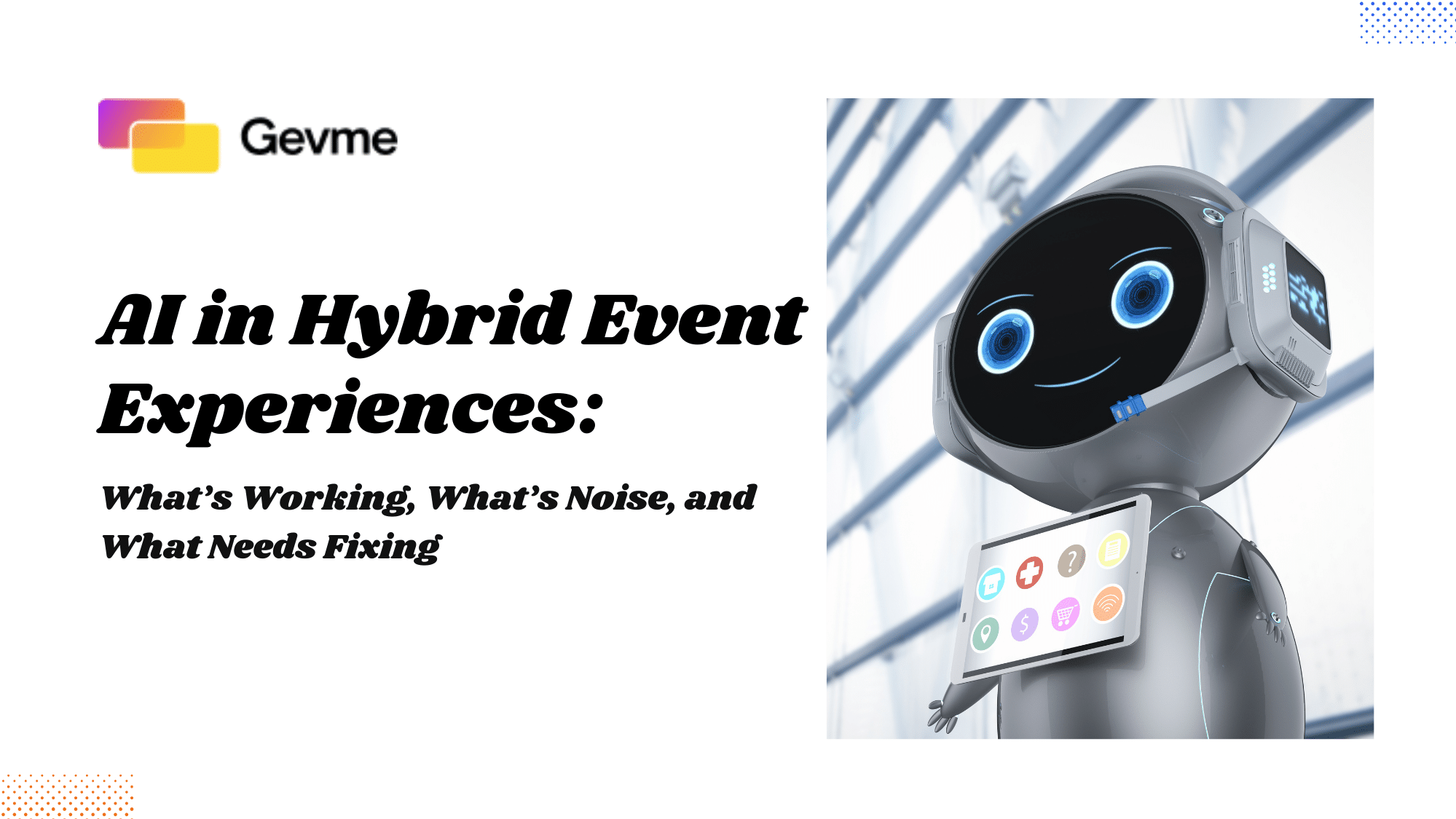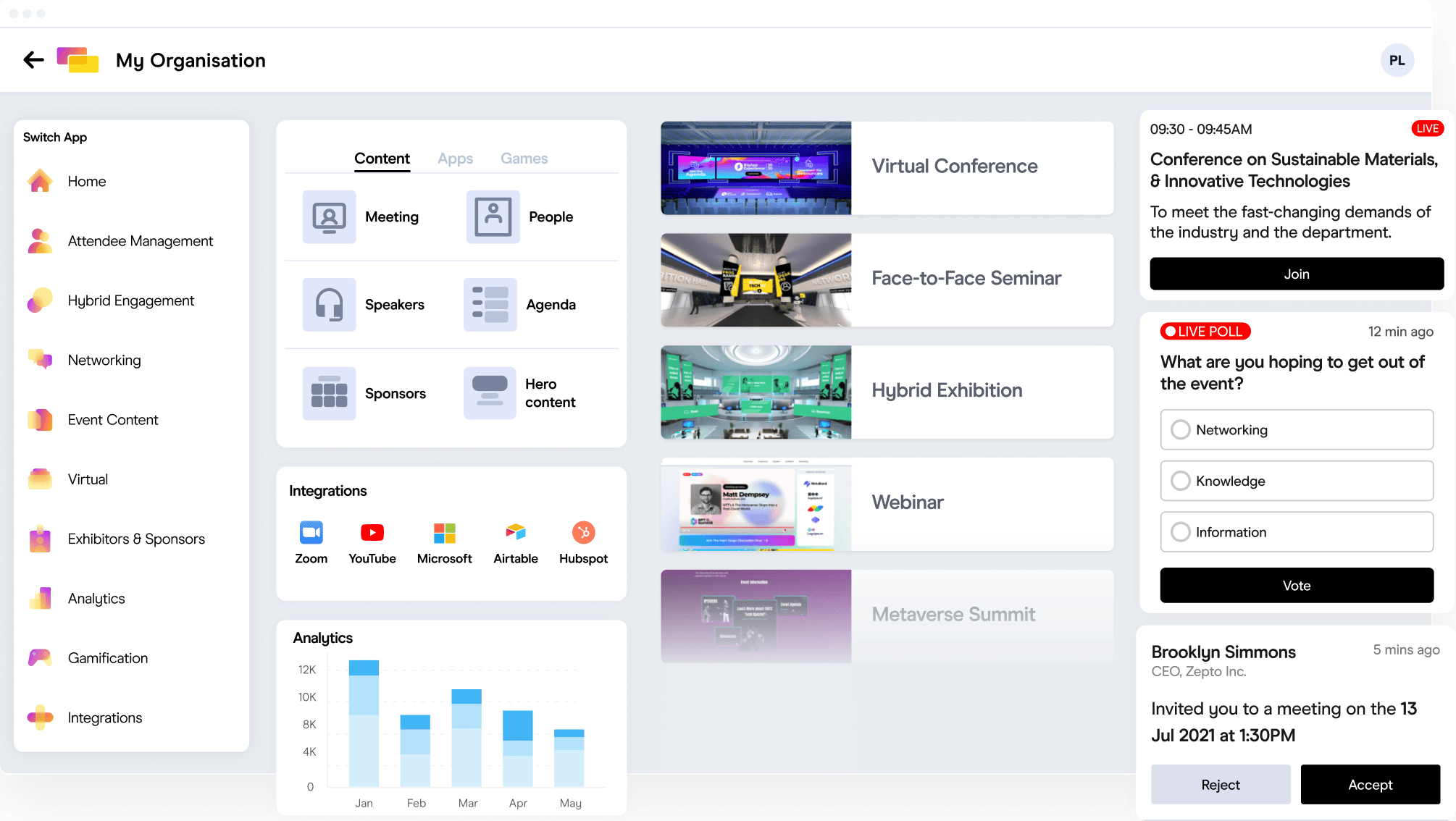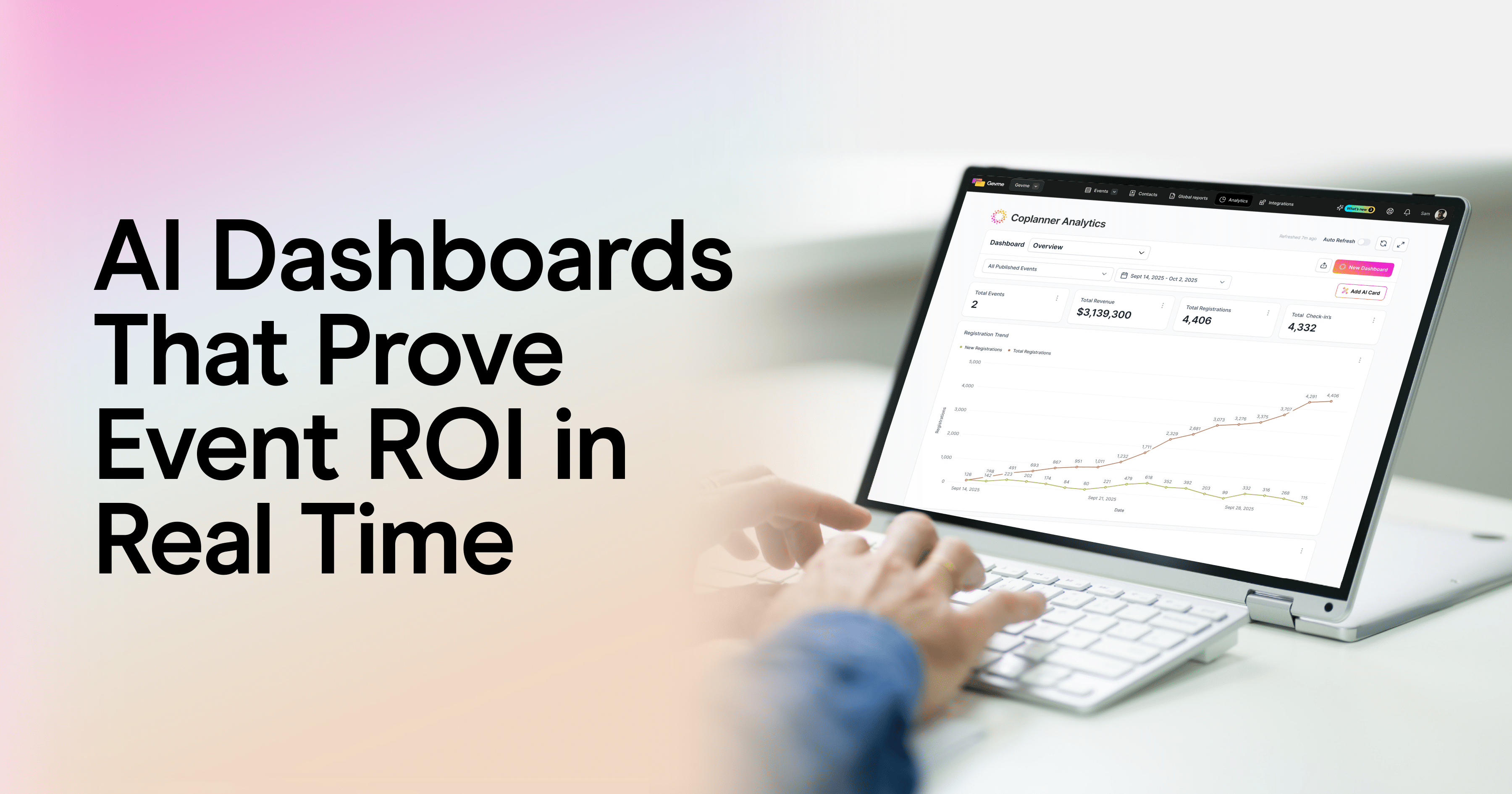Everyone’s selling it.
“AI in hybrid event experiences” is the new must-have, the new differentiator, the silver bullet. But behind the pitch decks, most implementations barely go beyond surface-level automation.
Real AI doesn’t just recommend sessions or automate emails. It makes the event smarter in motion. It steps in when things shift. It helps close the gap between virtual and in-person participation – not just in theory, but in onboarding, content delivery, networking, support, and analytics.
AI’s Role in Hybrid Event Experiences
AI isn’t a mere novelty layer. It should provide the operational support for running two events in parallel.
That includes:
- Monitoring attention across environments – detecting not just when people join or leave, but when they stop engaging. That includes digital signals (drop-offs, skipped segments, muted tabs) and in-room cues (session energy, silent disengagement).
- Personalising without friction – pairing attendees based on real-time behavior, not just form-fill interests. Think: a delegate who just asked a live question gets routed to a breakout with others who showed high engagement on similar themes.
- Adjusting delivery on the fly – not everyone experiences content the same way. Some need visual takeaways, others prefer transcript snippets, and a few want the 60-second “just tell me what happened” version. AI helps map that dynamically.
- Rerouting the plan when conditions shift – be it a session going overtime, a speaker dropping out, or a sudden surge in virtual interest, AI can rebalance resources or surface the right fallback options without human scrambling.
The real power of AI in hybrid event experiences lies in orchestration – behind the scenes, mid-show, while everything’s still in motion. Not just surfacing “what happened,” but actively shaping what happens next.
Personalization Only Works If It’s Built on Real Signals
Personalized recommendations are often promised, rarely delivered well. If the system isn’t tracking real-time behavior – drop-offs, session switches, questions asked, networking interest – then personalization becomes a list of generic suggestions.
Useful personalization in hybrid settings means:
- Recommending sessions based on platform-specific viewing patterns
- Spotting disengagement and adjusting content flow before people leave
- Surfacing trending questions to moderators while the session is still live
Done right, personalization doesn’t feel “smart.” It just feels right.
Networking: Let Behavior Drive the Match
Networking is harder in hybrid. One group’s grabbing coffee. The other’s behind a screen, unsure who’s worth reaching out to.
This is where AI either supports real connection or reinforces the disconnect.
The strongest systems:
- Use behavior and shared interests to suggest relevant 1:1s
- Identify active, high-engagement attendees in real time
- Propose physical or virtual meetups based on shared schedules and focus areas
Remote attendees shouldn’t feel like observers. In-person participants shouldn’t get irrelevant matches. AI needs to balance both with context-aware recommendations.
Real-Time Adaptation: Where AI Shows Its Value
Most event platforms operate in a fixed schedule. Timings, sessions, formats, all decided weeks in advance.
But once the event starts, the reality shifts:
- One session draws a huge virtual crowd, another draws light foot traffic in person.
- Attendees get Zoom fatigue after lunch.
- A speaker’s delayed, and the agenda needs to flex.
This is where AI in hybrid event experiences goes beyond buzzwords.
A smart system can:
- Auto-adjust session lengths based on engagement signals.
- Suggest interactive formats when attention dips.
- Flag low-engagement zones before they become pain points.
This isn’t crisis management. It’s design that adjusts to live conditions.
Accessibility Isn’t a Bonus Feature. It’s the Bare Minimum.
AI is often touted as a tool for inclusivity, but most deployments stop at auto-captions and translation.
That’s the starting line, not the finish.
At recent events, real-time content intelligence helped close that gap. With tools like Snapsight running across sessions, teams could generate:
- Live summaries for late joiners or multi-track attendees who couldn’t be everywhere at once
- Multilingual recaps and captions across 80+ languages
- Custom playback formats and takeaways to keep audiences engaged without needing to rewatch entire sessions
- Sentiment signals and idea clouds that highlighted what really resonated in the room
Hybrid audiences bring wider needs, preferences, and access requirements. Supporting them should be foundational, not optional.
Predictive Analytics: Only Useful If It’s Trusted
The most useful analytics also highlights what’s next, not just what already happened.
Predictive analytics in hybrid events can:
- Predict no-shows and reallocate spots
- Anticipate session capacity constraints before they occur
- Inform future programming based on micro-patterns in attendee behavior
But predictive tools only work when:
- The data is consistently clean
- The AI learns across multiple events
- The outputs influence actual planning decisions
If the system keeps flagging the obvious (e.g., “keynotes are popular”), it’s not offering insight – it’s stating the baseline.
The Tech That Just Works: What It Looked Like at AIME 2025
At AIME 2025, one of Asia-Pacific’s largest MICE trade shows, the difference wasn’t a shiny AI layer. It was execution.
Gevme powered the event with systems that ran consistently, across both in-person and digital touchpoints. With tools designed to reduce friction at scale.
Here’s what ran under the hood:
- Faster check-ins, fewer queues: Self-service kiosks powered by the Gevme Kiosk App quick rapid badge printing and real-time attendance syncing. Wait times dropped. Data stayed clean.
- Smarter exhibitor operations: The Gevme Exhibitor Portal gave companies a self-serve interface to manage profiles, assign badges, and upgrade packages. Less manual coordination, more time for business.
- Live content summaries with Snapsight: AI-powered session summarization helped attendees capture key insights on the fly, in multiple languages. Silent Sessions also became accessible after the fact.
- Unified insights, not stitched-together data: In-person and virtual attendance were tracked in one live dashboard. Organizers didn’t need to toggle between systems or chase exports to get a real-time view.
This wasn’t a showcase of AI. It was a stress test and the systems held up, from Day 0 prep to live delivery.
The Real Test of AI in Hybrid Event Experiences
It’s not whether the tech sounds impressive.
It’s whether:
- Queue times shrink
- Networking makes sense
- Drop-off slows down
- Ops teams move from firefighting to refining
AI isn’t just a tool. It’s part of the infrastructure. It should simplify, not complicate.
If the platform still needs ten tabs, three exports, and a backup hotspot to survive day one, it’s not “AI-powered.” It’s patchwork.
Final Word
AI in hybrid event experiences isn’t judged by what sounds promising, it’s measured by what actually holds up when things go live.
Skip the marketing sizzle. Focus on what strengthens the system.
Ask:
- Does it improve the attendee experience, wherever they are?
- Does it support the team running the show?
- Does it continue working even when conditions change?
If the answer’s no, it’s not innovation. It’s noise.
And in a hybrid event, noise is the first thing to eliminate.
FAQ’s
AI in hybrid event experiences refers to the use of artificial intelligence to enhance both virtual and in-person event participation. It helps with personalization, engagement tracking, networking, and real-time adaptation.
AI in hybrid event experiences tracks real-time signals like drop-offs, questions, and participation. It then personalizes content delivery and session recommendations to keep attendees engaged.
Yes. AI in hybrid event experiences matches attendees based on shared interests and behaviors, suggesting relevant 1:1s, meetups, or breakouts that foster meaningful connections.
Hybrid events are unpredictable. AI in hybrid event experiences adjusts content, session formats, and schedules on the fly to prevent disengagement and ensure smooth delivery.
AI in hybrid event experiences goes beyond reporting past performance. It provides predictive analytics, helping organizers forecast attendance, spot engagement trends, and optimize future event planning.




